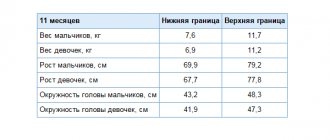By two months, the baby becomes more active and inquisitive. To replenish energy, normal growth and development, he needs to eat properly. It is important to correctly create a regimen and calculate the daily amount of food.
Much depends on what type of feeding the baby is on: breast or artificial. It is important for parents to know how much a baby should eat at 2 months and how often to feed him.
How often should a 2 month old baby eat?
According to the classical scheme, a two-month-old baby should eat about six times a day. You need to feed your baby every 2.5-3.5 hours during the day and 3-4 at night. It is not recommended to take long gaps between meals.
The permissible break in feeding at night is 6 hours. Most two-month-old babies sleep more soundly and longer in the dark.
Therefore, 1-2 feedings may be enough at night. Some babies sleep restlessly and require milk several times a night. The diet of a two-month-old baby depends on what type of feeding he is on. Infants are given milk upon request. Typically the interval between feedings is 2.5 hours.
Artificial people eat less often. This is due to the fact that infant formula takes longer to digest than breast milk. For two-month-old babies, the breast is not only a source of food, but also makes it possible to feel safe and calm. Therefore, during the first months, many pediatricians recommend feeding the baby on demand.
Breastfeeding has a number of benefits:
- stimulates lactation;
- satisfies the baby's sucking reflex;
- ensures normal mental development.
The frequency of feeding also depends on a number of baby factors:
- activity;
- body weight;
- speed of metabolic processes;
- health conditions;
- volume of a single serving.
An individual approach to premature babies is especially important. All their reflexes are not fully formed. They cannot feed on demand. Therefore, a special regime is being developed for them, which is recommended to be strictly followed.
It is easy to understand that a baby is hungry by the following changes in his behavior:
- refusal of day or night sleep;
- cry;
- capriciousness.
A well-fed baby looks cheerful, active, and gains weight well. Only a mother who is constantly nearby and already knows the peculiarities of her baby’s behavior can assess the well-being of a two-month-old baby.
How much should a two month old baby eat?
The nutritional needs of a 2-month-old baby, or more precisely in its quantity, depend on several factors:
- appetite;
- mood;
- physical activity during the day;
- well-being;
- weight and height at birth;
- individual metabolism.
A hungry baby himself gives signals that it is time to feed him, you just need to watch him:
- the awakened baby begins to open and close his mouth;
- sticks out tongue, smacks lips;
- when a nursing mother picks him up, he looks for the breast and begins to turn his head;
- grunts;
- cries if previous signals were not heard and correctly understood.
The average nutritional norm for a healthy full-term baby is 7 meals per day, the single volume of one meal is 100-120 ml, the total volume per day is approximately 800-850 ml. The interval between feedings should not exceed 3-3.5 hours. In the future, as they grow older, the intervals between feedings will increase.
Important! A healthy full-term baby should not be woken up for the next feeding. He'll eat when he wakes up.
The baby has woken up and is ready to eat a hearty meal
How much should you eat?
The question of how much a baby should eat at 2 months worries many young mothers. There are norms for food consumption at two months of age. For infants - this is 800 ml of milk, for bottle-fed children - 700 ml of an adapted formula.
But these figures are conditional. Pediatricians pay great attention to weight. If a child gains at least 600 grams in a month, this means that he eats enough milk or formula for growth and development.
You can determine how much food a baby needs at 2 months using the following methods:
- Reich . The baby's weight and height are taken into account. Body weight in grams is divided by length in centimeters. The result obtained is multiplied by 7. The formula is quite easy to use and accurate;
- Shkarina . This is the simplest system for calculating the amount of food a child needs. According to Shkarin's method, a two-month-old baby should eat 800 ml of milk. Every month 50 ml of nutrient fluid is added;
- Gayburna . A 2-month-old baby requires milk or an adapted formula in the amount of 1/6 of his body weight.
But we must remember that each person is individual. Therefore, one baby at two months of age may require 600 ml of breast milk, and another - 900 ml.
It is easy to determine whether a child has enough food by the amount of urine excreted. To do this, you need to give up diapers for a day. If there are more than 10 wet diapers, this means that the baby has enough milk.
Artificial feeding at 2 months
Artificial feeding at 2 months is a critical period for a baby. By this age they are switched to formula only for medical reasons. The baby is fed by the hour so as not to overload the digestive system and not provoke regurgitation or colic.
Table of contents
|
Indications for transferring an infant at 2 months of age to formula
It is recommended to continue natural feeding (mother's milk) for as long as possible, at least until 6 months of age.
Mother's milk contains all the vitamins, microelements, proteins, fats, antibodies that contribute to the normal development of the baby.
But there are cases when a baby is transferred to artificial nutrition:
• lack of lactation due to illness (thyroid pathologies, autoimmune diseases and others);
• the mother’s categorical refusal to breastfeed for mental and other reasons;
• child abandonment;
• maternal illness that requires the use of drugs incompatible with breastfeeding;
• separation of mother from baby due to treatment or operations;
• the presence of HIV infection, hepatitis, syphilis, the treatment of which is not compatible with breastfeeding.
In these conditions, the baby begins to be fed with formula.
What to feed a baby at 2 months and how much
A 2 month old baby's diet consists only of formula. Meals are selected individually as prescribed by the local pediatrician. Classification of mixtures:
• fermented milk: Nutrilak, Hipp, Frisolak;
• antireflux: Frisovo, Bellakt, Samper Lemolak;
• cows hydrolyzed with milk protein: Frisolak, Alfare;
• with amino acids: Neocate, Alfare Amino;
• with goat milk protein: Similak, Nenny;
• with soy: Friso, Bellakt.
Fermented milk nutrition is intended to prevent and treat dysbiosis. They contain digestive bacteria, which colonize the intestines.
Antireflux mixtures are prescribed by pediatricians in the presence of severe symptoms of regurgitation, including hidden reflux (food is thrown into the esophagus, but does not enter the oral cavity).
Hydrolyzed nutrition is essential to reduce the likelihood of cow's milk protein allergy.
If these mixtures are not effective and are not suitable for the baby, food with goat protein is prescribed.
Children with a history of allergies (cow protein intolerance, diathesis, urticaria and other diseases) are advised to eat foods containing amino acids or soy.
Soy mixtures are not prescribed for allergies to soy protein.
Nestozhen and other cheap formulas should not be tried by the age of 2 months, since the baby’s digestion is very sensitive to the quality of nutrition.
But it happens that a child tolerates even budget formulas well.
Useful tips for mothers: MIXED AND ARTIFICIAL FEEDING
The amount of food per day depends on the weight of the baby. The calculation is carried out using the formula: 1/6 of body weight. Example: baby weight – 4400 g; 4400/6 = 733 per day.
A 2-month-old baby needs to be fed 6-7 times a day. Therefore, the daily amount of artificial milk is divided by the frequency of feedings. Example: 733/7 = 104 ml.
The break between feedings should be 3-4 hours. Artificial food contains proteins that take a long time to digest in the stomach.
If you feed your baby more often, he will develop diarrhea or constipation, regurgitation, and colic.
Schedule
Daily routine is very important for the well-being and development of the baby. It is compiled individually, adapting to the baby.
Approximate daily routine:
| Time | Action |
| 7:00 | waking up, feeding |
| 9:30 – 11:00 | hygiene measures, feeding, sleep in the morning |
| 11:30 | feeding |
| 11:30 — 13:30 | a walk combined with outdoor recreation |
| 13:30 – 14:30 | games, communication with mom, feeding |
| 14:30 — 16:30 | sleep during the day |
| 16:30 – 19:00 | games, communication with mom, feeding |
| 17:30 — 19:30 | sleep in the evening |
| 19:30 – 21:00 | games, communication with mother |
| 23:00 | bathing, eating |
| 23:30 – 6:00 | rest at night + 2 feedings |
This routine can be adjusted to suit the baby's wishes.
Formula feeding rules
The baby is fed on an hourly basis. For feeding you need to buy bottles.
It is advisable to choose them with a wide neck that imitates the mother's breast. If a child has just been transferred to artificial feeding, then he is accustomed to bottles with a wide neck.
This way he will learn to suck the bottle nipple faster.
Before feeding, bottles are washed and sterilized in boiling water for 5-10 minutes.
First, the bottle must be completely disassembled into parts so that all contacting surfaces of the parts are open and in contact with boiling water.
Select a nipple for the bottle with a medium-sized hole so that the mixture (when turned over) drips and does not flow.
For a formula-fed baby, be sure to buy pacifiers. They are necessary to satisfy the sucking reflex, since bottle feeding lasts much less than breastfeeding.
Breastfeed the baby in your arms or in a baby's bed. When feeding in the mother's arms, the baby's head is raised at an angle of 30ᵒ.
The bottle is given with the nipple upside down. The nipple must be completely filled with liquid so that there is no air leak through the hole.
The baby eats for up to 5-10 minutes, some children eat slowly - 15 minutes.
Crib feeding helps teach your baby to sleep alone. The head end of the mattress is raised at an angle of 20-30ᵒ, the child is laid on his side.
A cushion is placed under the back to prevent the baby from turning over and choking. The bottle is given at an angle of 30-35ᵒ.
In this position, the nipple will be filled with milk. Place 1-2 diapers under the bottle for fixation. During feeding, the baby must be monitored.
How to breed food
Any package of the mixture contains instructions for its preparation. The rules for dilution and dosage are written there. Each type of food has its own dosage.
Any mixture is diluted the same way. First, boil water of the required volume, then cool it to 30-35ᵒC.
After cooling, milk powder is poured into the feeding container and filled with water. The bottle is closed with a lid that protects the milk from pouring out through the nipple, and the mixture is shaken until the dry substance is completely dissolved.
After these manipulations, the baby is fed.
Do not leave dry residues in the diluted mixture. Poorly mixed liquid has a negative effect on the digestive tract and is poorly absorbed.
The baby's colic increases, bloating, diarrhea or constipation appears.
Complementary feeding at 2 months
It is strictly forbidden to feed children 2 months of age with adult food. He has not formed the act of swallowing or the digestive tract.
Consequences of introducing early complementary feeding (reasons for their occurrence):
• development of diseases of the digestive tract (damage to the mucous membrane of the stomach and intestines, lack of enzymes);
• dyspeptic manifestations (enzyme deficiency);
• allergy (underdeveloped immunity).
These manifestations can impair development and last a lifetime.
If a child develops anemia, malnutrition, constipation and other conditions that require treatment, then specialized nutrition is prescribed.
It corrects hemoglobin levels, improves digestion, softens stools, and relieves dysbacteriosis.
Therefore, at 2 months, mixtures rather than complementary foods are used to eliminate diseases.
Transfer to artificial feeding should be carried out only on the recommendations of the local pediatrician.
You cannot stop breastfeeding on your own. When switching to artificial feeding, careful selection of the formula is required to prevent abdominal pain, dyspepsia, allergies and other manifestations.
Olga Kuznetsova
DOCTOR - PEDIATRIC Education: Siberian State Medical University. Certificate of specialist in the specialty "Pediatrics"
Norm amount of food taking into account the baby's weight
Nutritional standards are calculated in different ways.
Pediatricians advise giving preference to those formulas that take into account the child’s weight. These include the methods of Reiche and Geibern. Weight gain is one of the main indicators of health and proper development. For example, a child’s weight at two months is 5 kg and height is 56 cm. Based on this, the optimal amount of food according to the Reiche formula is 625 ml per day (5000: 56x7 = 625).
According to Gayburn's method, a baby of two months of age with similar parameters needs to eat 833 ml of milk (5000:6=833). The resulting figures have a significant difference. This confuses many parents. The results presented indicate that all norms are advisory in nature and should not be followed unquestioningly.
Some experts advise calculating the average between the upper and lower limits of the norm, dividing the resulting figure by the number of feedings per day. The volume of a single serving depends on what the parents feed the baby: breast milk or an adapted formula. Baby food fills your baby faster. Therefore, it is required less than breast milk.
When determining the volume of daily and single portions of food, parents should pay attention to the following factors:
- health status;
- activity;
- body type.
For example, active children can eat more than normal at one time. For calm babies, a small portion may be enough.
Strict and flexible feeding regimes
The choice of feeding schedule depends on the baby's weight, appetite and sleep schedule. Previously, pediatricians recommended sticking to a strict schedule. Children weighing 3.5 kg or more were instructed to breastfeed every four hours. Such strictness resulted in digestive problems. Supporters of a strict schedule still hold the opinion that on-demand feeding pampers newborns.
Many babies adapted to feeding by the hour, but there were always children for whom a strict diet in the first months of life was contraindicated. Some cannot eat enough milk, others fall asleep half-starved, others do not want to sleep and shout “not on schedule.”
Fortunately, pediatricians have allowed modern mothers to breastfeed their babies when needed. A flexible schedule is not at all harmful to digestion and does not spoil your character. Children on a flexible schedule wake up no more than 6-7 times a day, and by the end of the second month, four meals a day are enough.
You shouldn’t go to extremes and give your baby the breast every time he wakes up. For calm children, this approach is acceptable, but if the baby wakes up and cries frequently, the life of a nursing mother can turn into continuous feeding.
What if a two month old baby doesn't eat much?
If a child eats little, this causes great concern among parents. There is no need to sound the alarm right away. We need to figure out why the baby eats less than normal. The reasons can be physiological and pathological.
Physiological group of factors:
- slow metabolism. May be due to the individual characteristics of the body;
- The baby does not like the taste of milk or formula . It happens that food for artificial people turns out to be tasteless, despite its high quality and usefulness. A child may refuse breast milk if the mother does not follow a diet, eats fatty foods, garlic, onions, spicy spices, sour and smoked foods. Some foods worsen the taste of mother's milk. Therefore, they need to be abandoned. If the child does not like the mixture, then it is better to replace it;
- passivity . The lower the child’s motor activity, the energy consumption decreases, the less food he needs to replenish his strength;
- incorrectly chosen position for feeding . Your baby may find it difficult to breastfeed or eat from a bottle. In this case, he will be capricious and consume less milk than normal;
- stress _ When switching from artificial feeding to breastfeeding, children often begin to eat worse. When you find yourself in an unfamiliar environment, your appetite also decreases.
Pathological causes include:
- gastritis;
- colic;
- bowel dysfunction;
- influenza, ARVI;
- liver diseases;
- diabetes.
If a child eats little, but develops normally, looks cheerful and active, then there is no need to worry. This means that a small amount of milk is enough for him. If the baby is capricious or has symptoms of the disease, then you should urgently consult a doctor.
It is important to pay attention to weight gain. If the pace has slowed down, the baby is lagging behind in growth, then you need to feed him more often. At the same time, you should not increase the serving size.
How much milk should children drink at different ages?
Milk and dairy products are an important part of a healthy and complete children's diet. But how much milk should children drink at different ages? Gastroenterologist Svetlana Isakova tells.
Half of the child's diet should consist of milk and dairy products. Milk proteins are easily digestible and do not require intense work of the digestive glands. Fat is a building material for cells; fatty acids take part in the formation of the nervous system. Milk sugar (lactose), entering the intestines, serves as a favorable environment for the proliferation of beneficial microflora. In addition, lactose promotes better absorption of calcium. In childhood, calcium ensures the formation of bone tissue, participates in the process of blood clotting, and ensures normal excitability of nervous tissue and contractility of skeletal muscles.
By drinking one glass (240 g) of whole milk, a child receives: 8 g of protein; 11 g carbohydrates; up to 8 g fat; 300 mg calcium (35% of the daily value for schoolchildren); vitamin B2; vitamin B12 (30% of the daily value for children); vitamin D (25% daily value for children and adults); vitamin A (10% daily value for children and adults); zinc (10% daily value for children and adults).
In addition, milk and dairy products are an important source of iodine. 100 g of milk contains up to 16 mcg of iodine, and kefir up to 14 mcg. The daily norm for children is about 90-120 mcg. Iodine is one of the most important elements for the normal functioning of a child’s body. There is very little iodine in the child’s body, and it is quickly used up for the needs of the body. If not enough iodine is supplied with food, then iodine deficiency gradually increases, which can lead to quite serious consequences - for example, endemic goiter.
Required amount of dairy products per day (according to the recommendations of the Ministry of Health):
Children from 1-3 years old
- Cottage cheese 25 g
- Milk kefir 500 g
- Sour cream 10 g
- Cheese 5 g
Children from 4-6 years old
- Cottage cheese 30 g
- Milk kefir 450 g
- Sour cream 10 g
- Cheese 5 g
Children from 7-10 years old
- Cottage cheese 60 g
- Milk kefir 500 g
- Sour cream 15 g
- Cheese 5 g
Children from 11 to 14 years old
- Cottage cheese 70 g
- Milk kefir 450 g
- Sour cream 25 g
- Cheese 10 g
At the same time, no other product can replace milk - over the entire evolutionary period, our digestive system has been completely adapted to the consumption of milk. In case of insufficient milk consumption by a child, there is a risk of developing a deficiency of a number of nutrients, which can lead to disruption of intestinal activity, the formation of the bone skeleton and metabolic processes - that is, they can cause disturbances in physical and psychomotor development.
But what should mothers whose children suffer from milk intolerance do? People usually think that the cause of their discomfort is lactose intolerance, but this diagnosis is often wrong. Research shows that for most people, the cause of intolerance lies not in lactose, but in the A1 protein. When digested, this milk protein often increases the risk of inflammation and causes discomfort such as pain, bloating or constipation. The thing is that when protein A1 is digested, the opioid fragment BKM-7 is released, which can not only cause discomfort, but also generally negatively affect the health and well-being of both children and adults.
If you are intolerant to regular milk, try introducing A2 milk into your diet - natural milk without A1 protein. Switching to A2 milk reduces the risk of inflammatory processes and may lead to an overall improvement in intestinal transit in children. However, A2 milk is not suitable for children with a confirmed allergy to milk proteins. In such cases, it is necessary to refuse any milk and additionally give vitamins and nutritional supplements. In all other cases, A2 milk will be a complete alternative to regular milk.
How not to overfeed an infant?
You need to feed your baby in moderation. If the baby is malnourished, he may experience deviations in the development of internal organs and systems.
This can lead to various dangerous pathologies. Overeating is also harmful. Children whose mothers overfeed become overweight. Excess weight negatively affects the condition of internal organs and systems.
Such a baby may develop diabetes, heart and vascular problems. The baby gets used to eating a lot. Obesity causes problems at school: such a child may be teased and bullied. There are children who eat a lot, but remain thin, or, conversely, drink little milk, but gain a lot of weight. This is explained by the peculiarities of metabolism.
It is not uncommon for a mother to lose breast milk for certain reasons. Then you have to transfer the child to artificial feeding. Not all parents know that baby food is more filling and takes longer to digest. For this reason, the mother may overfeed the baby.
To understand whether your baby is overeating, you need to pay attention to the following points:
- baby's mood . If the baby is active and cheerful after feeding, this means that he is well-fed, but not overfed. Whims and crying may indicate discomfort in the abdomen due to overeating;
- state of the gastrointestinal tract . If your baby eats too much, he may spit up a lot after feeding;
- dream . An overfed baby sleeps poorly.
Pediatricians give the following advice to parents on how not to overfeed their baby:
- weigh the baby before and after feeding;
- contact a specialist to calculate the dose of milk or adapted formula required for the child. You can determine the rate of food consumption yourself, using well-known methods;
- do not increase the single amount of milk or infant formula when the number of feedings per day decreases;
- Do not force feed your baby. As practice shows, free-fed children develop normally and gain weight.
How to tell if your baby is full
Temperature on a child's teeth
The baby ate and fell asleep calmly. Mom is still worried: is there enough milk (formula) for him? Maybe he still needs to feed more, because he is small and cannot say for himself? In addition, during breastfeeding it is quite difficult to understand how many milliliters the baby has eaten, since there are no marks on the chest with divisions of volume.
For this, there is indirect evidence of the “fullness” of a 2-month-old baby:
- The number of urinations per day is within 10-12 times. This is easy to calculate if the baby is in a cloth diaper or swaddle. Then you just need to count the number of soiled diapers or inserts in a reusable diaper. It is harder when the child is in a disposable diaper. In this case, it is worth adhering to the principle that the diaper should be filled between feedings. Urine should be clear, odorless and colorless.
- By consistency and regularity of stool. A well-fed baby should have a light yellow mass in the diaper without large inclusions; its thickness resembles sour cream.
- The weight gain per week should be 150 grams. You need to weigh yourself at the same time before feeding in the same diaper or clean, dry diaper.
- The child’s behavior is calm, does not become capricious without reason, and is active between naps.
- Presence of motor skills according to his age – able to hold his head in an upright position, raises his head when lying on his stomach.
- A restful night's sleep. A hungry child will not sleep at night and will not let others sleep either.
Well-fed baby
There are cases when a two-month-old baby does not eat the established amount of food, while steadily gaining weight, his night sleep lasts 6-7 hours, and his hungry cries are inaudible. This means that what he eats is enough for him.
Video on the topic
About the development of a baby at two months in the video:
Thus, there are norms for the consumption of milk and adapted formula for children of two months of age. They should be adhered to. But you shouldn’t blindly follow these standards. We must understand that each baby’s body is individual.
When determining the optimal amount of food, it is necessary to take into account mood, the speed of metabolic processes, and the development of the child. A pediatrician can calculate the normal single dose of milk and the number of feedings.
How to set up a routine
You can safely wake up your child every three to four hours if he does not wake up from hunger. Don't make him cry for too long, but gradually adjust the frequency of feedings. As you gain weight, the intervals will increase.
- A child weighing up to 4 kg must be put to the breast every 3 hours.
- With a weight of 4 to 4.5 kg, the intervals can be increased to 4 hours.
- By the end of the second month, many babies do without night feedings.
If the baby is clearly hungry earlier, you need to feed him - you may not have enough breast milk yet.
Typically, two-month-old babies need to be fed 5-7 times a day, but this is very individual. Minor deviations are acceptable.
Nutritional Features
The forced measure of transferring a child to artificial feeding is carried out strictly under the supervision of a pediatrician. If the mother is still in the prenatal center, the baby is fed donor milk for the first 2-3 days. After being discharged home, the woman will have to constantly prepare a fresh mixture based on adapted products.
Additional Information. The composition of the mixture is as close as possible to breast milk in terms of the quantitative content of carbohydrates, proteins, fats and other nutrients. The product contains at least 15 different vitamins and 11 micro- and macrocomponents.
Modern mixtures are produced in categories for:
- children born healthy;
- low birth weight and premature babies;
- prone to allergies.
For each period of newborns, their own mixtures are selected (from the first days to a month, up to 3, 6, 12 months). Therefore, it is necessary to start artificial nutrition strictly with the starting product.
Adapted infant formulas
When feeding a baby with formula from birth, it is important to properly organize high-quality nutrition. If you do not follow the rules and regimen, there are risks of both overfeeding and underfeeding the baby
Therefore, it is advisable to weigh newborns in the first months of life at least 2 times a week.
If there is a delay in body weight for more than 10 days, a change in diet will be required: switching to another mixture, introducing curds, prescribing fish oil. Controlling weight gain includes calculating calorie intake, daily and single volumes of formula, taking into account the baby’s life expectancy.
Baby formulas for supplementary feeding
Two-month-old babies are given special adapted mixtures called hydrolysates. This food is deliberately made less tasty than mother's milk, otherwise the baby may refuse to breastfeed. The “on demand” diet with mixed nutrition is maintained. At the beginning of feeding, the baby is given both breasts, and only after that - baby food.
You cannot feed your baby hydrolyzate from a bottle with a nipple. Use a special system, a spoon or syringe without a needle.
The introduction of supplementary feeding does not mean that its share in nutrition will increase. The mother has the opportunity to activate lactation and exclude factory supplementary feeding from the menu.
Mixed nutrition has several advantages:
- No allergic reactions.
- Obtaining useful substances, including antibodies, from mother's milk.
- The mother can restore lactation and continue full breastfeeding.











